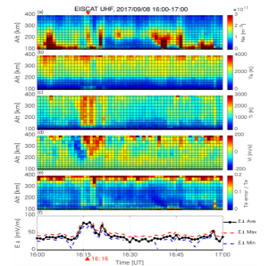Low-Altitude Ion Upflow Observed by EISCAT and its Effects on Supply of Molecular Ions in the Ring Current Detected by Arase (ERG) (Takada et al., 2021)2021.5.20
EISCAT observations during 16-17 UT on September 8, 2017. From top to bottom, each panel shows (a) electron density, (b) electron temperature, (c) ion temperature, (d) ion velocity, (e) error ratio of electron temperature, and (f) electric field perpendicular to the magnetic field derived from electron heating at 111 km altitude based on empirical relations reported by a previous statistical study (Davies & Robinson, 1997).
During the magnetic storm starting on September 7, 2017, the MEP-i instrument onboard the Arase (ERG) satellite observed molecular ions (O2+/NO+/N2+) in the ring current. The molecular ions were observed by Arase in four orbits during this magnetic storm. This indicates that there was a continuous molecular ion supply from the ionosphere. During the storm main phase around the second Dst minimum (100 nT) on September 8, 2017, the European Incoherent Scatter (EISCAT) radar observed the ion upflow (50-150 m s-1) in the low-altitude (250-350 km) ionosphere together with strong ion heating up to >2,000 K. The convective electric field derived from the electron heating observed by EISCAT at an altitude of approximately 110 km was also enhanced by a factor of 2. The observations suggest that the additional ion heating at low altitudes helps to cause the fast upflow and transport molecular ions upward. The flux decreases from 280 to 350 km altitudes due to the dissociative recombination was estimated to be approximately two orders of magnitude. This resulted in significant molecular ion flux remaining at 350 km altitude. These results suggest that the low-altitude ion upflow caused by the ion frictional heating enables molecular ions to escape to space against rapid loss by the dissociative recombination.
Takada et al., Low-altitude ion upflow observed by EISCAT and its effects on supply of molecular ions in the ring current detected by Arase (ERG), JGR, doi:10.1029/2020JA028951, 2021.
カテゴリ:Outflow

